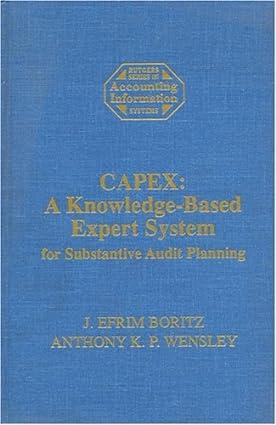Question
1. Differential Analysis for a Lease-or-Sell Decision Inman Construction Company is considering selling excess machinery with a book value of $281,900 (original cost of $400,000
1.
Differential Analysis for a Lease-or-Sell Decision
Inman Construction Company is considering selling excess machinery with a book value of $281,900 (original cost of $400,000 less accumulated depreciation of $118,100) for $277,500, less a 5% brokerage commission. Alternatively, the machinery can be leased to another company for a total of $286,700 for five years, after which it is expected to have no residual value. During the period of the lease, Inman Construction Company's costs of repairs, insurance, and property tax expenses are expected to be $25,500.
a. Prepare a differential analysis, dated May 25 to determine whether Inman should lease (Alternative 1) or sell (Alternative 2) the machinery. For those boxes in which you must enter subtracted or negative numbers use a minus sign.
| Differential Analysis | |||
| Lease Machinery (Alt. 1) or Sell Machinery (Alt. 2) | |||
| May 25 | |||
| Lease Machinery (Alternative 1) | Sell Machinery (Alternative 2) | Differential Effect on Income (Alternative 2) | |
| Revenues | $ | $ | $ |
| Costs | |||
| Income (Loss) | $ | $ | $ |
b. On the basis of the data presented, would it be advisable to lease or sell the machinery? Explain.
The net from selling is $.
2.
Differential Analysis for a Discontinued Product
A condensed income statement by product line for Crown Beverage Inc. indicated the following for King Cola for the past year:
| Sales | $233,100 |
| Cost of goods sold | 109,000 |
| Gross profit | $124,100 |
| Operating expenses | 144,000 |
| Loss from operations | $(19,900) |
It is estimated that 16% of the cost of goods sold represents fixed factory overhead costs and that 19% of the operating expenses are fixed. Since King Cola is only one of many products, the fixed costs will not be materially affected if the product is discontinued.
a. Prepare a differential analysis, dated March 3, to determine whether King Cola should be continued (Alternative 1) or discontinued (Alternative 2). If an amount is zero, enter zero "0". Use a minus sign to indicate a loss.
| Differential Analysis | |||
| Continue King Cola (Alt. 1) or Discontinue King Cola (Alt. 2) | |||
| January 21 | |||
| Continue King Cola (Alternative 1) | Discontinue King Cola (Alternative 2) | Differential Effect on Income (Alternative 2) | |
| Revenues | $ | $ | $ |
| Costs: | |||
| Variable cost of goods sold | |||
| Variable operating expenses | |||
| Fixed costs | |||
| Income (Loss) | $ | $ | $ |
b. Should Star Cola be retained? Explain.
As indicated by the differential analysis in part (A), the income would by $ if the product is discontinued.
3.
Make-or-Buy Decision
Companion Computer Company has been purchasing carrying cases for its portable computers at a purchase price of $62 per unit. The company, which is currently operating below full capacity, charges factory overhead to production at the rate of 45% of direct labor cost. The fully absorbed unit costs to produce comparable carrying cases are expected to be as follows:
| Direct materials | $24 |
| Direct labor | 21 |
| Factory overhead (45% of direct labor) | 9.45 |
| Total cost per unit | $54.45 |
If Companion Computer Company manufactures the carrying cases, fixed factory overhead costs will not increase and variable factory overhead costs associated with the cases are expected to be 15% of the direct labor costs.
a. Prepare a differential analysis dated February 24 to determine whether the company should make (Alternative 1) or buy (Alternative 2) the carrying case. If required, round your answers to two decimal places. If an amount is zero, enter "0". For those boxes in which you must enter subtracted or negative numbers use a minus sign.
| Differential Analysis | |||
| Make Carrying Case (Alt. 1) or Buy Carrying Case (Alt. 2) | |||
| February 24 | |||
| Make Carrying Case (Alternative 1) | Buy Carrying Case (Alternative 2) | Differential Effect on Income (Alternative 2) | |
| Sales Price | $ | $ | $ |
| Costs: | |||
| Purchase price | $ | $ | $ |
| Direct materials per unit | |||
| Direct labor per unit | |||
| Variable factory overhead per unit | |||
| Fixed factory overhead per unit | |||
| Income (Loss) | $ | $ | $ |
b. Assuming there were no better alternative uses for the spare capacity, it would to manufacture the carrying cases. Fixed factory overhead is to this decision.
Step by Step Solution
There are 3 Steps involved in it
Step: 1

Get Instant Access to Expert-Tailored Solutions
See step-by-step solutions with expert insights and AI powered tools for academic success
Step: 2

Step: 3

Ace Your Homework with AI
Get the answers you need in no time with our AI-driven, step-by-step assistance
Get Started


